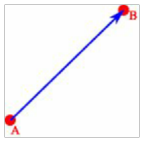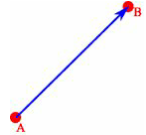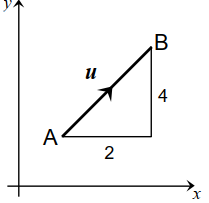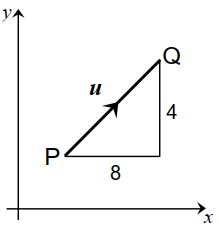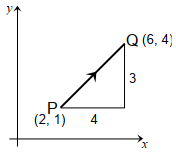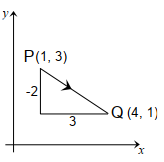- Introduction
- Representation of Vectors
- Equivalent Vectors
- Addition of Vectors
- Zero Vector
- Multiplication of a Vector by a Scalar
- More Illustrations
- Position Vector
- Traslation vector
- Summary on Vectors
- Past KCSE Questions on the Topic.

Introduction
- A vector is a quantity with both magnitude and direction, e.g. acceleration velocity and force. A quantity with magnitude only is called scalar quantity e.g. mass temperature and time.

Representation of Vectors
- A vector can be presented by a directed line as shown below:
- The direction of the vector is shown by the arrow.
- Magnitude is the length of AB
- Vector AB can be written as ⃑AB or AB
- Magnitude is denoted by |AB|
- A is the initial point and B the terminal point

Equivalent Vectors
- Two or more vectors are said to be equivalent if they have:
- Equal magnitude
- The same direction.
Equal vectors - two vectors are equal if they have the same magnitude and direction as shown in the fgure below
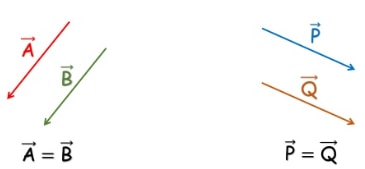
Negative vectors - Two vectors are negative of each other if they have the same magnitude and opposite directions as shown in the figure below
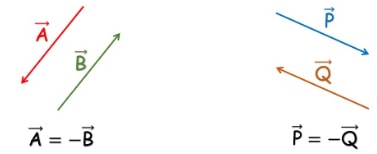

Addition of Vectors
- A movement on a straight line from point A to B can be represented using a vector. This movement is called displacement
- Consider the displacement from ⃗u followed by ⃗v

- The resulting displacement is written as ⃗u + ⃗v

Zero Vector
- Consider a diplacement from A to B and back to A .The total displacement is zero denoted by O
- This vector is called a Zero or null vector.
AB + BA = O
If a + b = 0 , b = -a or a = - b

Multiplication of a Vector by a Scalar
Positive Scalar
If AB= BC =CD=a
A______B______C______D>
AD = a + a +a =3a
Negative Scalar
- Subtraction of one vector from another is performed by adding the corresponding negative Vector.
- That is, if we seek a - b we form a + (-b).
DA = (- a) + (-a) + (-a)
= -3a
The Zero Scalar
- When vector a is multiplied by o, its magnitude is zero times that of a. The result is zero vector.
a.0 = 0.a = 0
Multiplying a Vector by a Scalar
- If k is any positive scalar and a is a vector then ka is a vector in the same direction as a but k times longer.
- If k is negative, ka is a vector in the opposite direction to a and k times longer.

More Illustrations
- A vector is represented by a directed line segment, which is a segment with an arrow at one end indicating the direction of movement. Unlike a ray, a directed line segment has a specific length.
- The direction is indicated by an arrow pointing from thetail(the initial point) to the head (the terminal point). If the tail is at point A and the head is at point B, the vector from A to B is written as:
notation:| ⃗AB|
(Vectors may also be labeled as a single bold face letter, such as vector v.)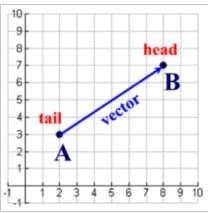
- The length (magnitude) of a vector v is written |v|. Length is always a non-negative real number.
- As you can see in the diagram below, the length of a vector can be found by forming a right triangle and utilizing the Pythagorean Theorem or by using the Distance Formula.
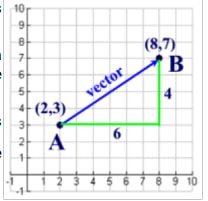
- The vector at the right translates 6 units to the right and 4 units upward. The magnitude of the vector is 2√13 from the Pythagorean Theorem, or from the Distance Formula:
| ⃗AB| = √[(8−2)2 + (7−3)2] = 2√13 - The direction of a vector is determined by the angle it makes with a horizontal line.
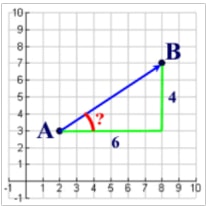
- In the diagram above, to find the direction of the vector (in degrees) we will utilize trigonometry. The tangent of the angle formed by the vector and the horizontal line (the one drawn parallel to the x-axis) is 4/6 (opposite/adjacent).
tan ∠ A = 4/6
tan-1 (4/6) ≈ 33.7o - A free vector is an infinite set of parallel directed line segments and can be thought of as a translation. Notice that the vectors in this translation which connect the pre-image vertices to the image vertices are all parallel and are all the same length.
- You may also hear the terms "displacement" vector or "translation" vector when working with translations.

Position Vector
- To each free vector (or translation), there corresponds a position vector which is the image of the origin under that translation. Unlike a free vector, a position vector is "tied" or "fixed" to the origin. A position vector describes the spatial position of a point relative to the origin.

Traslation Vector
- Translation vector moves every point of an object by the same amount in the given vector direction.
- It can be simply be defined as the addition of a constant vector to every point.
- Translations and vectors: The translation at the left shows a vector translating the top triangle 4 units to the right and 9 units downward. The notation for such vector movement may be written as:

- Vectors such as those used in translations are what is known as free vectors. Any two vectors of the same length and parallel to each other are considered identical. They need not have the same initial and terminal points.
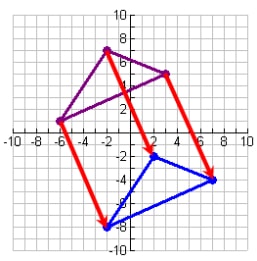
Example
The points A (-4 ,4 ) , B (-2 ,3) , C (-4 , 1 ) and D ( - 5 , 3) are vertices of a quadrilateral. If the quadrilateral is given the translation T defined by the vector (5/-3)draw the quadrilateral ABCD and its image under T
Solution

Summary on Vectors
|
Components of a Vector in 2 dimensions: To get from A to B you would move:
The components of the vector are these moves in the form of a column vector. thus Similarly: |
A 2-dimensional column vector is of the form |
|
Magnitude of a Vector in 2 dimensions: We write the magnitude of u as |u| u = The magnitude of a vector is the length of the directed line segment which represents it. Use Pythagoras’ Theorem to calculate the length of the vector. |
The magnitude of vector u is |u| (the length of PQ)
and so |
|
Examples:
|
Solutions:
|
|
Vector:
Scalar:
|
Examples: Displacement, force, velocity, acceleration. Examples: Temperature, work, width, height, length, time of day. |

Past KCSE Questions on the Topic.
- Given that 4p − 3q =
and p + 2q =
find
- p and q (3 mks)
- |p+2q| (3 mks)
- Show that A (1 , -1 ), B (3, 5) and C (5, 1 1 ) are collinear (4 mks)
- Given the column vectors a =
b =
c =
and that p = 2a − 1/3b + c
- Express p as a column vector (2 marks)
- Determine the magnitude of p (1 mark)
- Given the points P(−6, −3), Q(−2, −1 ) and R(6, 3) express PQ and QR as column vectors. Hence show that the points P, Q and R are collinear. (3 mks)
- The position vectors of points x and y are x = 2i + j − 3k and y=3i + 2j − 2k respectively. Find x y as a column vector (2 mks)
- Given that a =
b =
c =
and p = 2a + b − 3c . Find |p|(3mks)
- The position vectors of A and B are
 and
and  respectively. Find the coordinates of M which divides AB in the ratio 1 :2. (3 marks)
respectively. Find the coordinates of M which divides AB in the ratio 1 :2. (3 marks) - The diagram shows the graph of vectors ⃗EF, ⃗FG and ⃗GH.
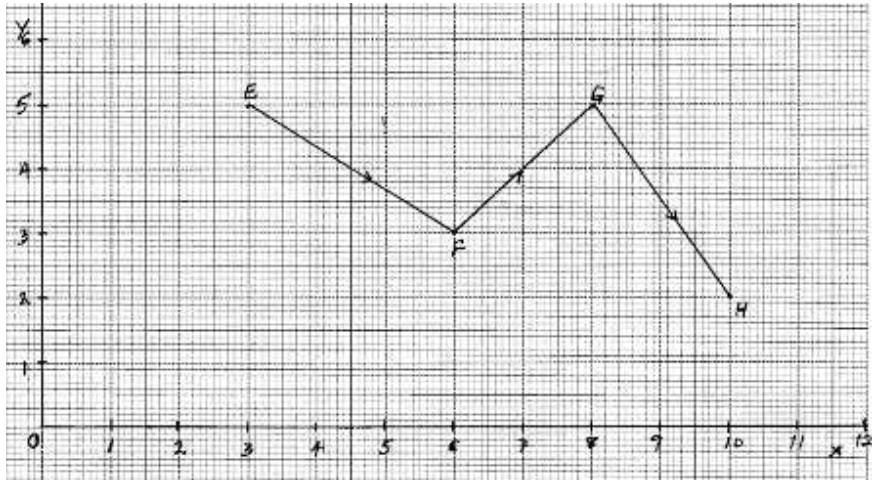
Find the column vectors;- ⃗EH (1 mk)
- |⃗EH| (2mks)
- OA = 2i − 4k and OB = −2i + j − k. Find |⃗AB|(2mks)
- Find scalars m and n such that
m + n
+ n  =
= 
- Given that p = 2i − j + k and q = i + j +2k, determine
- │p + q│ (1 mk
- │1/2p − 2q│(2 mks)
Download Vectors I - Mathematics Form 2 Notes.
Tap Here to Download for 50/-
Get on WhatsApp for 50/-
Why download?
- ✔ To read offline at any time.
- ✔ To Print at your convenience
- ✔ Share Easily with Friends / Students

